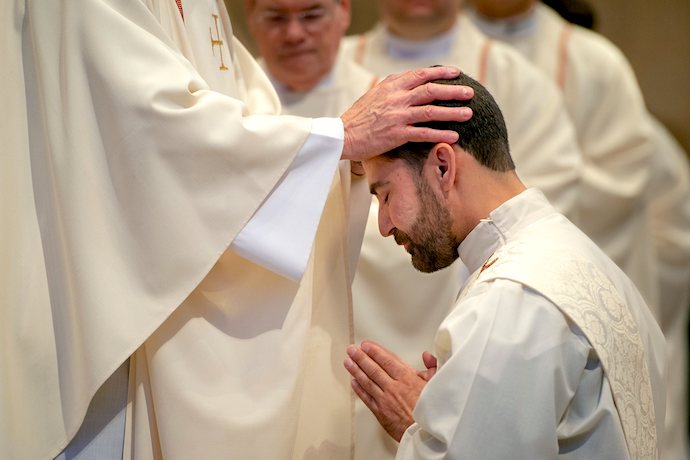For the first time in centuries the ordination of women is on the table in the Roman Catholic Church. It has arisen as a real possibility through the Synod on Synodality, which was launched by Pope Francis in October 2021. While the document Enlarge the Space of Your Tent notes that the synodal process unearthed a near universal call from around the world for women deacons, it also notes that some parts of the world are also calling for women priests. If both priesthood and the diaconate are officially open for discernment, then why is the discussion about female deacons getting far more traction?
The Roman Catholic Church has developed a layered theological understanding of the sacrament of ordination, also known as holy orders. At the risk of oversimplifying this dense theology, there are essentially two tracks for holy orders. Bishops and priests are defined as participating in the ministerial priesthood of Christ while deacons are intended to serve the bishops and priests. Importantly, deacons are not defined as “lesser” priests, but have a fundamentally different role. The Church makes the theological distinction: deacons are not “standing in for Christ,” but rather assisting the men who do.
While the institutional Church in recent decades has invested a great amount of time and energy into preventing even the discussion of female priests, the diaconate has increasingly become a topic of exploration. Even before the Synod on Synodality, Pope Francis created two commissions to study the question of women deacons, one in 2016 and one in 2020, signaling to the worldwide Church that a female diaconate was open for discernment. What this clearly indicates is that the institutional Church has split the discussion of women’s ordination into two separate questions, one that is viable (the diaconate) and one that is not (the priesthood).
In this context, it is undeniably advantageous to accept the institutional framing of ordination as two separate questions. Advocating for the diaconate without the priesthood affords broad access to the institutional Church. For example, groups have been convening in parishes for months to discuss ordaining women as deacons. Bishops, priests, and deacons openly support women deacons and also serve publicly as advisors to the women deacons movement. Advocates for women deacons were allowed to be present at the annual LA Congress and the annual assembly of the Association of U.S. Catholic Priests—a privilege not extended to those working for women priests. Articles on women deacons are routinely published in the Catholic press. And the cherry on top? Pope Francis has now held a private audience with women called to the diaconate.
The cost of a ‘diaconate-only’ strategy
While approaching the ordination of women as two distinct questions is clearly efficacious, it’s also remarkably costly. To bring the cost to light, let us imagine the impact of a Church that ordains women as deacons, but not priests or bishops.
First, while there’s no question that the Church would immensely benefit from the extensive gifts that women would bring as deacons, the reality is that a female diaconate doesn’t transform the Church’s power structure in any meaningful way. This, of course, is the fundamental reason why the institutional Church is so willing to engage on the issue in the first place. It’s safe: ordaining women as deacons but not priests keeps Church authority solely in the hands of men. The patriarchal structure remains entirely intact.
Next, a female diaconate creates what might be described as a clerical sub-caste vulnerable to abuse by an all-male authority. Male deacons already lament that their role isn’t well understood or respected. How much worse will it be for female deacons? Not only are women (and children) unsafe within the Roman Catholic patriarchy, it’s also highly likely that this female labor will be exploited or misused. Remember: deacons are defined theologically as the servants of the bishops and priests. To put it simply, women will be serving far more powerful men.
Such gendered tiers will be highly problematic in an organization historically prone to abuse of power. Furthermore, in terms of the content of their work, Pope Francis has remarked that “there is a way to imagine [the female diaconate] with a different view from the male diaconate.” Once again, the patriarchy wants to define for women what is proper to women, reiterating the all-too-familiar and troublesome “separate but equal” refrain of complementarity. A servant class of women doing things defined by men for men? History has proven there is serious reason to be concerned about such an arrangement. Frankly, it’s irresponsible and unethical for the Church to place women in this vulnerable position with no representation at the highest levels.
Finally, and most distressing, is that should the Church agree to ordain women as deacons but not as priests, the institutional Church will get to portray itself to the world as if it is embracing progress, all while it insulates itself from true transformation. The institutional Church will get to present a crumb from the table as if it’s a feast, but the people will still go home hungry.
Moreover, because this decision masquerades as a win for women, the demand for women’s equality will naturally slump, which will enable the Church to delay the real change that’s needed—priesthood for women—for decades or longer. Most gut-wrenching of all, the historic opening now present will close, and the Church will have squandered its chance.
The political expediency that results from pursuing a female diaconate without the priesthood is not worth its devastating cost to women as a whole, to the larger Church, or even to the world. It would be far better for the Church not to ordain women at all. At least then the Church wouldn’t be able to hide behind a Pyrrhic victory. At least then the Church couldn’t escape the mounting scrutiny of its hypocritical treatment of women. At least then the Church would be forced under unrelenting pressure to finally confront its history of sexism rather than delay it indefinitely.
Getting down to brass tacks, ordination in the Roman Catholic Church—whatever the track—is best understood as a vocation from God. If this is the case, then there’s only one question: do women have the right to live out our vocation or not? To frame ordination in any other way is disingenuous.





